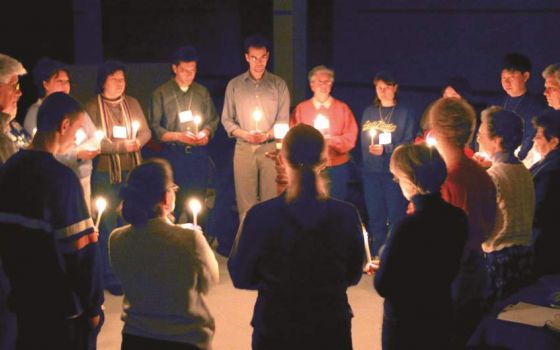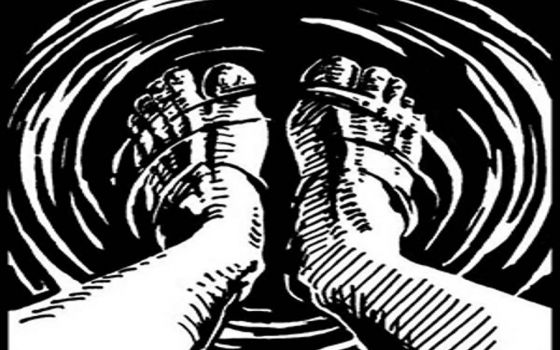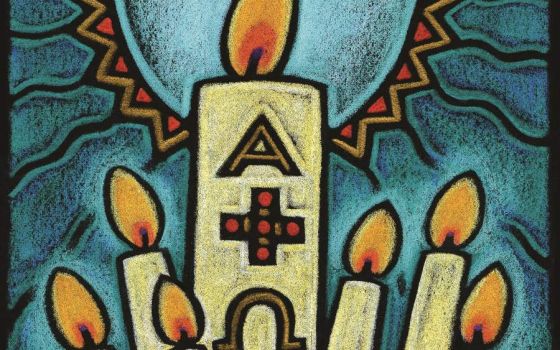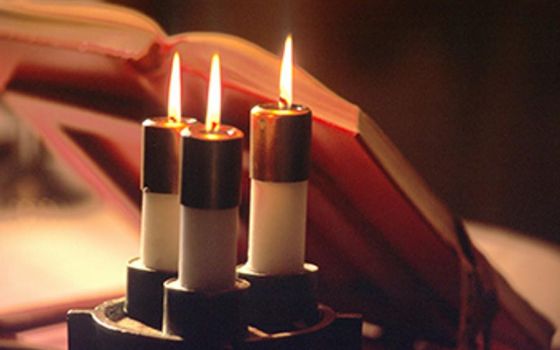
Art by Julie Lonneman
Sometimes the meaning of a word in one context can obscure rather than illuminate the meaning of that same word in different contexts. While "scrutiny" ordinarily refers to an examination or investigation, the scrutinies that are celebrated as part of the Lenten initiation rites are not examinations conducted about or by the elect, but rather are rites of prayer and exorcism.
The scrutinies are an integral part of the Lenten season, which originated as a season of baptismal preparation. By the fourth century, Lent developed as a formal period of intensive spiritual preparation that followed a lengthy time of catechetical formation.
In this early era of the church, exorcisms were celebrated regularly during the formation of catechumens to help free them from the powers of evil as they grew in their conversion to Christ. The culmination of this process took place during the weeks before Easter, when the scrutinies — solemn exorcisms — were celebrated by the bishop in the presence of the entire community to help the elect to be freed of any remaining obstacles to their wholehearted conversion to the way of Christ.
Today, the scrutinies are celebrated during Mass on the Third, Fourth and Fifth Sundays of Lent. They "are meant to uncover, then heal all that is weak, defective, or sinful in the hearts of the elect; to bring out, then strengthen all that is upright, strong, and good" (Rite of Christian Initiation of Adults, 141). As in earlier centuries, the scrutinies are to be celebrated publicly "in such a way that the faithful in the assembly will also derive benefit from the liturgy of the scrutinies and join in the intercessions for the elect" (RCIA, 145).
The celebration of the scrutinies is intimately linked to the proclamation of God's Word, and so the readings from Year A are always used regardless of the current cycle. The scrutiny rites and their texts flow directly from the three Gospel stories of the Samaritan woman at the well (John 4:5-42), the man born blind (John 9:1-41) and the raising of Lazarus (John 11:1-45). In the scrutiny rites the community prays that Christ may satisfy the thirst of the elect, heal their blindness and save them from death.
Music ministers have an important role to play in planning and celebrating the scrutiny rites. After the homily, the presider invites the assembly to pray in silence, after which a litany of intercession for the elect is sung or said. Planners can foster the intensity of the assembly's prayer by choosing a strong sung response. Many hymnals and worship aids provide musical settings of responses specifically for the scrutiny rite, usually including a tone that may be used for the cantor to sing the petitions. Although the intercessions have the same format as the prayers of the faithful (general intercessions), they are not the same. Musicians and other planners should carefully study the two model sets of intercessions for each of the three scrutinies and adapt or expand them according to the needs of the elect and the local community. Both the texts and musical settings should invite the community to fervent prayer in the face of sin and evil.
Advertisement
The intercessions are followed immediately by an exorcism that forms the heart of the scrutiny rite. The exorcism consists of a prayer addressed to God the Father, the laying on of hands in silence and a prayer to Jesus. The solemnity of the scrutiny can be enhanced if the presider can sing one or both of these prayers and if there is a deep silence in the church while he lays hands on each of the elect.
After the exorcism, a song may be sung by all. Suggested psalm settings are provided for each of the scrutinies, but other texts may also be used, especially songs that proclaim the power of Christ over sin, evil, thirst, blindness and death, and might appropriately be connected to a psalm or song used elsewhere in the liturgy.
The song after the exorcism should of course not be joyful in character, but should nonetheless be strong and brief. Following the song, the elect are dismissed as usual.
Because the scrutinies are among the most important rites of the Lenten season and of the preparation of the elect for initiation, they deserve to be celebrated with care. Simple and well-chosen musical settings can help communities to participate in these rites with an intense spirit of prayer.
Editor's note: This reflection was originally published in the March 2011 issue of Celebration. Sign up to receive daily Lenten reflections.








